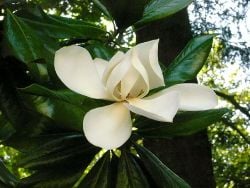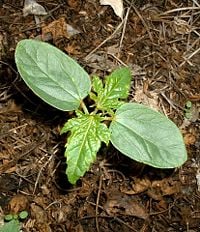Dicotyledon
| Magnoliopsida (Dicotyledons) | ||||||
|---|---|---|---|---|---|---|
 | ||||||
| Scientific classification | ||||||
| ||||||
|
See text. |

Dicotyledons or "dicots" is a name for a group of flowering plants whose seed typically contains two embryonic leaves or cotyledons. There are some 199,350 species within this group [1]. Flowering plants that are not dicotyledons are monocotyledons, typically having one embryonic leaf.
It is now accepted, thanks to the Angiosperm Phylogeny Group, that monocotyledons evolved from within the dicotyledons, and as such the latter form a paraphyletic group. This means that dicotyledons no longer are regarded as a "good" group, and the names "dicotyledons" and "dicots" are no longer to be used, at least in a taxonomic sense. The vast majority of the former dicots, however, form a monophyletic group called the eudicots or tricolpates. These may be distinguished from all other flowering plants by the structure of their pollen. Other dicotyledons and monocotyledons have monosulcate pollen, or forms derived from it, whereas eudicots have tricolpate pollen, or derived forms, the pollen having three or more pores set in furrows called colpi.
Traditionally the dicots have been called the Dicotyledones (or Dicotyledoneae), at any rank. If treated as a class, as in the Cronquist system, they may be called the Magnoliopsida after the type genus Magnolia. In some schemes, the eudicots are treated as a separate class, the Rosopsida (type genus Rosa), or as several separate classes. The remaining dicots (palaeodicots) may be kept in a single paraphyletic class, called Magnoliopsida, or further divided.
The following lists are of the orders formerly placed in the dicots, giving their new placement in the APG-system and that under the older Cronquist system, which is still in wide use.
| APG II | Cronquist system |
|
'Palaeodicots': basal orders
'Palaeodicots': Magnoliid complex
Eudicots Basal eudicots
Rosids Basal rosids
Eurosids I
Eurosids II
Asterids Basal asterids
Euasterids I
Euasterids II
|
Magnoliopsida Magnoliidae (mostly basal dicots)
Hamamelidae
Caryophyllidae
Dilleniidae
Rosidae
Asteridae
|
Compared to Monocotyledons
The schoolbooks list the differences between monocotyledons and dicotyledons as follows (obviously this is a broad sketch only, not to be taken literally):
Seeds: The embryo of the monocot has one cotyledon while the embryo of the dicot has two.
Flowers: The flower parts in monocots are multiples of three while in dicots are multiples of four or five.
Stems: In monocots, the stem vascular bundles are scattered, while in dicots they are in a ring.
Pollen: In monocots, pollen has one furrow or pore while in dicots they have three.
Roots: The roots are adventitious in monocots, while in dicots they develop from the radicle.
Leaves: In monocots, the major leaf veins are parallel, while in dicots they are reticulated.
Credits
New World Encyclopedia writers and editors rewrote and completed the Wikipedia article in accordance with New World Encyclopedia standards. This article abides by terms of the Creative Commons CC-by-sa 3.0 License (CC-by-sa), which may be used and disseminated with proper attribution. Credit is due under the terms of this license that can reference both the New World Encyclopedia contributors and the selfless volunteer contributors of the Wikimedia Foundation. To cite this article click here for a list of acceptable citing formats.The history of earlier contributions by wikipedians is accessible to researchers here:
The history of this article since it was imported to New World Encyclopedia:
Note: Some restrictions may apply to use of individual images which are separately licensed.